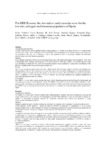Mostrar o rexistro simple do ítem
The ERICE-score: the new native cardiovascular score for the low-risk and aged mediterranean population of Spain
| dc.contributor.author | Gabriel, Rafael | |
| dc.contributor.author | Brotons, Carlos | |
| dc.contributor.author | Tormo, María José | |
| dc.contributor.author | Segura Fragoso, Antonio | |
| dc.contributor.author | Rigo, Fernando | |
| dc.contributor.author | Elosua, Roberto | |
| dc.contributor.author | Carbayo, Julio A. | |
| dc.contributor.author | Moral, Irene | |
| dc.contributor.author | Tuomilehto, Jaakko | |
| dc.contributor.author | Muñiz, Javier | |
| dc.date.accessioned | 2015-06-15T09:16:43Z | |
| dc.date.issued | 2014-08-22 | |
| dc.identifier.citation | Gabriel R, Brotons C, Tormo MJ, et al. The ERICE-score: the new native cardiovascular score for the low-risk and aged mediterranean population of Spain. Rev Esp Cardiol. 2015;68(3):205-215 | es_ES |
| dc.identifier.uri | http://hdl.handle.net/2183/14676 | |
| dc.description.abstract | [Abstract] Introduction and objectives. In Spain, data based on large population-based cohorts adequate to provide an accurate prediction of cardiovascular risk have been scarce. Thus, calibration of the EuroSCORE and Framingham scores has been proposed and done for our population. The aim was to develop a native risk prediction score to accurately estimate the individual cardiovascular risk in the Spanish population. Methods. Seven Spanish population-based cohorts including middle-aged and elderly participants were assembled. There were 11 800 people (6387 women) representing 107 915 person-years of follow-up. A total of 1214 cardiovascular events were identified, of which 633 were fatal. Cox regression analyses were conducted to examine the contributions of the different variables to the 10-year total cardiovascular risk. Results. Age was the strongest cardiovascular risk factor. High systolic blood pressure, diabetes mellitus and smoking were strong predictive factors. The contribution of serum total cholesterol was small. Antihypertensive treatment also had a significant impact on cardiovascular risk, greater in men than in women. The model showed a good discriminative power (C-statistic = 0.789 in men and C = 0.816 in women). Ten-year risk estimations are displayed graphically in risk charts separately for men and women. Conclusions. The ERICE is a new native cardiovascular risk score for the Spanish population derived from the background and contemporaneous risk of several Spanish cohorts. The ERICE score offers the direct and reliable estimation of total cardiovascular risk, taking in consideration the effect of diabetes mellitus and cardiovascular risk factor management. The ERICE score is a practical and useful tool for clinicians to estimate the total individual cardiovascular risk in Spain. | es_ES |
| dc.description.abstract | [Resumen] Introducción y objetivos. En España no existen unas cohortes poblacionales suficientemente grandes para hacer predicciones precisas del riesgo cardiovascular. Las ecuaciones de Framingham y EuroSCORE calibradas son las más utilizadas en España. El objetivo es desarrollar la primera ecuación de predicción autóctona para estimar con precisión el riesgo cardiovascular individual en España. Métodos. Análisis conjunto de siete cohortes españolas de población de mediana edad y anciana. La población del estudio —11.800 personas (6.387 mujeres)— aportó un total de 107.915 personas-año de seguimiento y 1.214 eventos cardiovasculares (633 de ellos, mortales). Se efectuó un análisis de regresión de Cox para examinar la contribución de los diferentes factores al riesgo de cualquier evento cardiovascular (mortal y no mortal). Resultados. La edad fue el principal factor de riesgo de eventos cardiovasculares. La presión arterial sistólica, la diabetes mellitus, el tabaquismo y el tratamiento antihipertensivo fueron factores predictivos fuertemente asociados con el riesgo cardiovascular. En cambio, la contribución del colesterol total sérico fue pequeña, especialmente en los mayores de 70 años. El modelo final de riesgo mostró un buen poder discriminatorio (estadístico C = 0,789 en varones y C = 0,816 en mujeres). Conclusiones. ERICE es una nueva ecuación de riesgo cardiovascular genuinamente española obtenida a partir del riesgo concurrente individual de los participantes en varias cohortes. La ecuación ERICE ofrece una estimación directa y fiable del riesgo cardiovascular total teniendo en cuenta factores como la diabetes mellitus y el tratamiento farmacológico de los factores de riesgo cardiovascular, habitualmente no incluidos en otras ecuaciones. | es_ES |
| dc.description.sponsorship | Instituto de Salud Carlos III; G03/065 | es_ES |
| dc.description.sponsorship | Instituto de Salud Carlos III; PI05/1464 | |
| dc.description.sponsorship | Instituto de Salud Carlos III; RD06/0014/0015 | |
| dc.language.iso | eng | es_ES |
| dc.publisher | Elsevier | es_ES |
| dc.relation.uri | http://dx.doi.org/10.1016/j.rec.2014.03.019 | es_ES |
| dc.rights | Creative Commons Licence | es_ES |
| dc.rights | Reconocimiento-NoComercial-SinObraDerivada 4.0 Internacional | |
| dc.rights.uri | http://creativecommons.org/licenses/by-nc-nd/4.0/ | |
| dc.subject | Risk score | es_ES |
| dc.subject | Low-cardiovascular risk | es_ES |
| dc.subject | Aging | es_ES |
| dc.subject | Mediterranean | es_ES |
| dc.subject | Diabetes mellitus | es_ES |
| dc.subject | Spain | es_ES |
| dc.subject | Ecuación de riesgo | es_ES |
| dc.subject | Bajo riesgo cardiovascular | es_ES |
| dc.subject | Envejecimiento | es_ES |
| dc.subject | Mediterráneo | es_ES |
| dc.subject | Diabetes mellitus | es_ES |
| dc.subject | España | es_ES |
| dc.title | The ERICE-score: the new native cardiovascular score for the low-risk and aged mediterranean population of Spain | es_ES |
| dc.type | info:eu-repo/semantics/article | es_ES |
| dc.rights.access | info:eu-repo/semantics/openAccess | es_ES |
| dc.date.embargoEndDate | 2015-08-22 | es_ES |
| dc.date.embargoLift | 2015-08-22 |
Ficheiros no ítem
Este ítem aparece na(s) seguinte(s) colección(s)
-
GI- GRINCAR - Artigos [203]






